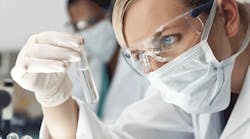To generate awareness and offer safeguards for laboratory workers, Workrite Uniform Co. has created a Top 5 list of laboratory hazards.
1. Fire/Explosions
In a laboratory, all chemicals and liquids should be treated as if they are as potent as gasoline. Vapors can travel long distances and may ignite if they reach a flame or spark. Be sure to keep a fire extinguisher on hand and ensure each individual in the laboratory knows its exact location to prevent fires from spreading. The appropriate personal protective equipment (PPE), like a flame-resistant (FR) lab coat, should also be worn.
2. Thermal and Chemical Burns
Many chemicals, both organic and inorganic, may be flammable or corrosive to the skin and eyes. It is important to exercise caution with chemicals to prevent spills and splashes. Additionally, the correct PPE always should be worn, such as lab coats that offer both FR properties and chemical-splash protection (CP).
Read more: Top 5 Laboratory Safety Tips [Photo Gallery]
3. Skin Absorption of Chemicals
Keeping chemicals away from direct contact with the skin is fundamental in laboratory safety. Even if chemicals are not corrosive, exposure can cause allergic reactions or other problems if absorbed by the skin.
Remember that gloves may be permeable to certain chemical reagents – even without visible deterioration – so trade out any gloves that have come into contact with such chemicals for a new pair immediately. Never touch your face or eyes until your hands are clean of all chemicals or solvents. As an extra precaution, wear a CP lab coat to prevent chemicals from wicking through fabric to the wearer.
4. Inhalation of Toxic Fumes
Many common solvents are extremely toxic if inhaled, and inhalation of certain chemicals severely can irritate membranes in the eyes, nose, throat and lungs. To reduce these risks, never evaporate excess solvents.
Laboratory workers also should maintain a safe distance when pouring chemicals and make sure there is proper ventilation in the lab.
5. Cuts to the Skin
Cuts to the skin are one of the most common types of laboratory accidents. In severe cases, nerves and tendons may be severed. Often, these injuries occur as a result of attempting to force a cork or rubber stopper into a piece of glass tubing, thermometer or distilling flask.
To prevent this accident from occurring, workers should make a proper-sized hole, lubricate the cork or stopper, and use gentle pressure with rotation on the glass portion.
